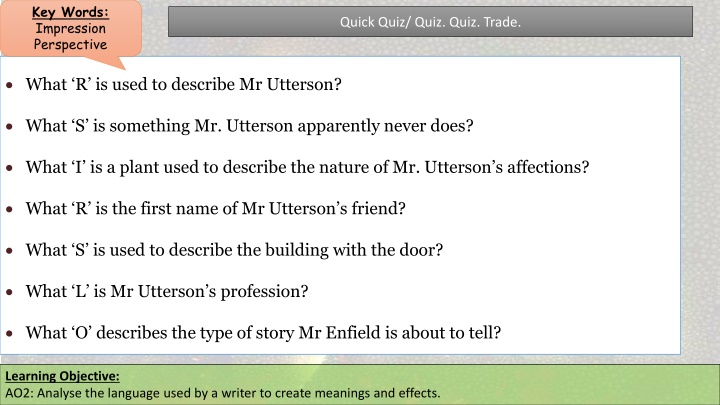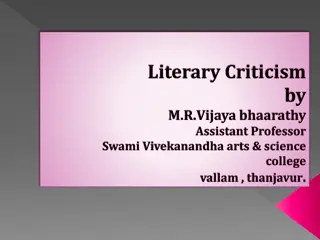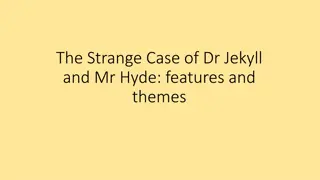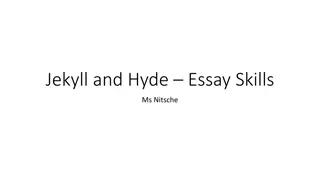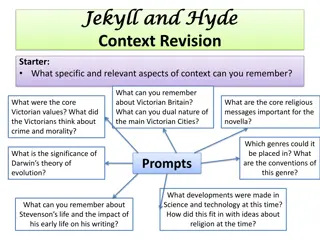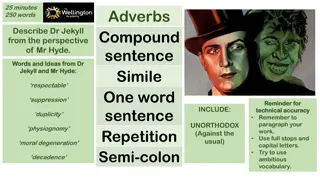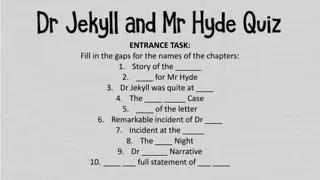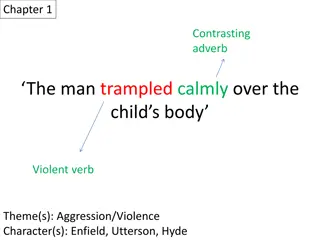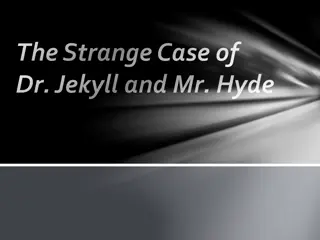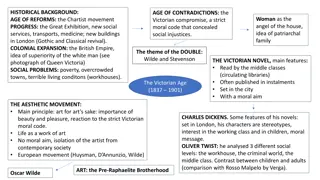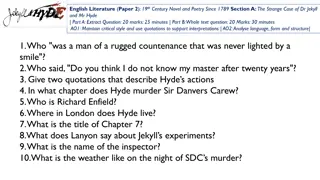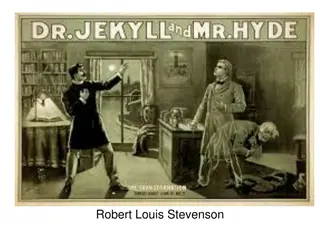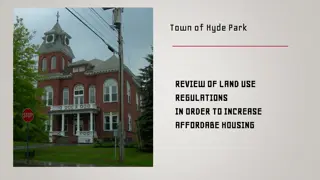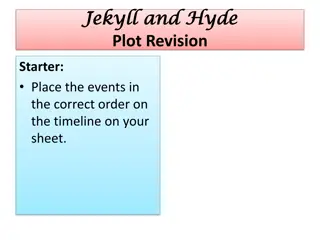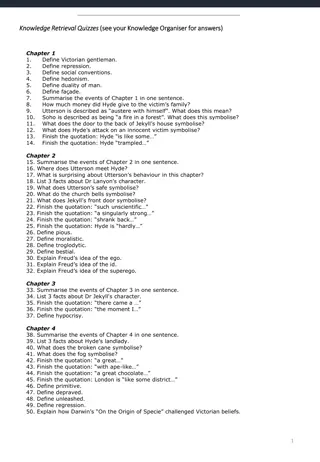Language Analysis and Literary Exploration in "The Strange Case of Dr. Jekyll and Mr. Hyde
Delve into the intricate language features used in "The Strange Case of Dr. Jekyll and Mr. Hyde" through quizzes, idiom interpretation, and symbolic analysis. Explore the characters, settings, and themes to unravel the captivating world created by Robert Louis Stevenson. Enhance your understanding of the text by dissecting language nuances and their effects on the reader.
Download Presentation

Please find below an Image/Link to download the presentation.
The content on the website is provided AS IS for your information and personal use only. It may not be sold, licensed, or shared on other websites without obtaining consent from the author.If you encounter any issues during the download, it is possible that the publisher has removed the file from their server.
You are allowed to download the files provided on this website for personal or commercial use, subject to the condition that they are used lawfully. All files are the property of their respective owners.
The content on the website is provided AS IS for your information and personal use only. It may not be sold, licensed, or shared on other websites without obtaining consent from the author.
E N D
Presentation Transcript
Key Words: Impression Perspective Quick Quiz/ Quiz. Quiz. Trade. What R is used to describe Mr Utterson? What S is something Mr. Utterson apparently never does? What I is a plant used to describe the nature of Mr. Utterson s affections? What R is the first name of Mr Utterson s friend? What S is used to describe the building with the door? What L is Mr Utterson s profession? What O describes the type of story Mr Enfield is about to tell? Learning Objective: AO2: Analyse the language used by a writer to create meanings and effects.
Key Words: Impression Perspective Quick Quiz/ Quiz. Quiz. Trade. What R is used to describe Mr Utterson? Rugged What S is something Mr. Utterson apparently never does? Smile What I is a plant used to describe the nature of Mr. Utterson s affections? Ivy What R is the first name of Mr Utterson s friend? Richard What S is used to describe the building with the door? Sinister What L is Mr Utterson s profession? Lawyer What O describes the type of story Mr Enfield is about to tell? Odd Learning Objective: AO2: Analyse the language used by a writer to create meanings and effects.
Key Words: Idiom Annotate Symbolise Recalling Information Quick quiz: Did you know? 1. At what time of the day does the trampling of the girl take place? 2. How old was the girl? 3. Was Hyde remorseful? Using only one word, describe Enfield s reaction to Hyde Mrs Stevenson told her husband to include the incident of the girl getting trampled to emphasise Hyde s brutality. It shocked middle-class Victorian readers who preferred to think of children safe at home. 4. Bonus question: Why might Stevenson choose to introduce Hyde in this way? Learning Objective: A02: Analyse language/ language features and their effect.
Key Words: Idiom Annotate Symbolise Lesson 3 The Story of the Door Section B Section B: : The Strange Case of Dr Jekyll and Mr Hyde Learning Objective: A02: Analyse language/ language features and their effect.
Key Words: Idiom Annotate Symbolise http://www.rhettcrowe.com/photos/source/scary_door.jpg Look at the idiom (phrase) you have been given. Decide what you think the meaning could be. Prepare to feedback. Extension: What could a door symbolise or represent? Learning Objective: A02: Analyse language/ language features and their effect.
Key Words: Idiom Annotate Symbolise Don t you lay that at my door! You will have to do that out of doors. At that point my boss showed me the door. Let s leave the door open in case you change your mind. I m sorry to say the old lady is at Death s door. You never know what goes on behind closed doors. It s not much, but it should help keep the wolf from the door. He was so famous that fans beat a path to his door. The father was so disappointed in his son, he shouted, Don t darken my door again! Learning Objective: A02: Analyse language/ language features and their effect.
Key Words: Idiom Annotate Symbolise Let s read back through the description of the house How might the house provide clues about its occupant? How is this setting typical or untypical of the gothic horror/ ghost story genre? Why do you think the windows are described in such a way? Why might they always be shut? Why do you think there is no bell or knocker on the door? Sketch the house/setting and annotate it with quotations from the text. 1. 2. 3. 4. 5. 6. Learning Objective: A02: Analyse language/ language features and their effect.
Key Words: Idiom Annotate Symbolise Stevenson was very interested in the contrast between good and evil and he showed this in how he described the setting of the story. As we read the extracts, if you hear a word that makes the setting seem grim and miserable, raise your red card. If you hear any words that make the setting seem pleasant, show your green card. Learning Objective: AO3: To understand the Victorian fascination with good and evil.
Key Words: Idiom Annotate Symbolise It chanced on one of these rambles that their way led them down a by-street in a busy quarter of London. The street was small and what is called quiet, but it drove a thriving trade on the weekdays. The inhabitants were all doing well, it seemed and all hoping to do better still - the shop fronts stood along that thoroughfare with an air of invitation, like rows of smiling saleswomen. Even on Sunday, when it veiled its more florid charms and lay comparatively empty of visitors, the street shone out in contrast to its dingy neighbourhood, like a fire in a forest; and with its freshly painted shutters, well-polished brasses, and general cleanliness and cheerfulness of note, instantly caught and pleased the eye of the passenger. Success Criteria: Success Criteria: Highlight words that create an effect explain what the effect is. Identify any: similes, metaphors, alliteration etc. explain why these have been used and what it makes the reader think or feel. Learning Objective: AO1/2: To be able to explain the effect of a writer s use of language, using quotations.
Key Words: Idiom Annotate Symbolise Two doors from one corner, on the left hand going east the line was broken by the entry of a court; and just at that point a certain sinister block of building thrust forward its gable on the street. It was two storeys high; showed no window, nothing but a door on the lower storey and a blind forehead of discoloured wall on the upper; and bore in every feature, the marks of prolonged and sordid negligence. The door, which was equipped with neither bell nor knocker, was blistered and distained. Tramps slouched into the recess and struck matches on the panels; children kept shop upon the steps; the schoolboy had tried his knife on the mouldings; and for close on a generation, no one had appeared to drive away these random visitors or to repair their ravages. Learning Objective: AO1/2: To be able to explain the effect of a writer s use of language, using quotations.
Key Words: Idiom Annotate Symbolise Note down the positive and negative descriptions. POSITIVE NEGATIVE Extension: Why do you think that Stevenson created this description in this way? What do you think his message is about Victorian society? What/ who else could it link to in terms of context? Learning Objective: AO3: To understand the Victorian fascination with good and evil. AO1/2: To be able to explain the effect of a writer s use of language, using quotations.
Key Words: Idiom Annotate Symbolise What impression does Stevenson give us of What impression does Stevenson give us of the setting? the setting? SQUAD SQUAD Challenge: How could this foreshadow the events in the rest of the book. Learning Objective: AO3: To understand the Victorian fascination with good and evil. AO1/2: To be able to explain the effect of a writer s use of language, using quotations.
Key Words: Idiom Annotate Symbolise Plenary Plenary Is the scene mostly positive or negative? Why do you think this is? How does it foreshadow (suggest/ hint at) what may happen later? To what extent do you think the opening pages of The Strange Case of Dr Jekyll and Mr Hyde establish the novel as belonging to the Gothic genre? Learning Objective: AO3: To understand the Victorian fascination with good and evil. AO1/2: To be able to explain the effect of a writer s use of language, using quotations.
